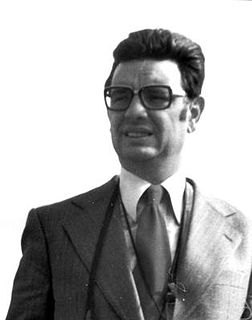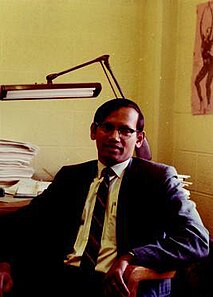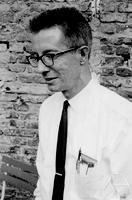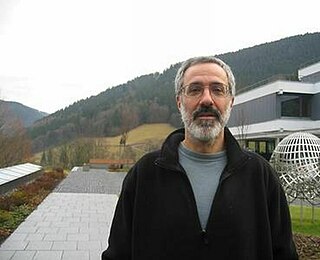Related Research Articles

Richard Manning Karp is an American computer scientist and computational theorist at the University of California, Berkeley. He is most notable for his research in the theory of algorithms, for which he received a Turing Award in 1985, The Benjamin Franklin Medal in Computer and Cognitive Science in 2004, and the Kyoto Prize in 2008.

Kenneth Geddes "Ken" Wilson was an American theoretical physicist and a pioneer in leveraging computers for studying particle physics. He was awarded the 1982 Nobel Prize in Physics for his work on phase transitions—illuminating the subtle essence of phenomena like melting ice and emerging magnetism. It was embodied in his fundamental work on the renormalization group.

Elwyn Ralph Berlekamp was a professor of mathematics and computer science at the University of California, Berkeley. Berlekamp was widely known for his work in computer science, coding theory and combinatorial game theory.

Raj Chandra Bose was an Indian American mathematician and statistician best known for his work in design theory, finite geometry and the theory of error-correcting codes in which the class of BCH codes is partly named after him. He also invented the notions of partial geometry, association scheme, and strongly regular graph and started a systematic study of difference sets to construct symmetric block designs. He was notable for his work along with S. S. Shrikhande and E. T. Parker in their disproof of the famous conjecture made by Leonhard Euler dated 1782 that there do not exist two mutually orthogonal Latin squares of order 4n + 2 for every n.

Arnold Ephraim Ross was a mathematician and educator who founded the Ross Mathematics Program, a number theory summer program for gifted high school students. He was born in Chicago, but spent his youth in Odessa, Ukraine, where he studied with Samuil Shatunovsky. Ross returned to Chicago and enrolled in University of Chicago graduate coursework under E. H. Moore, despite his lack of formal academic training. He received his Ph.D. and married his wife, Bee, in 1931.
Vladimir Iosifovich Levenshtein was a Russian scientist who did research in information theory, error-correcting codes, and combinatorial design. Among other contributions, he is known for the Levenshtein distance and a Levenshtein algorithm, which he developed in 1965.

Marshall Hall, Jr. was an American mathematician who made significant contributions to group theory and combinatorics.

Jacobus Hendricus ("Jack") van Lint was a Dutch mathematician, professor at the Eindhoven University of Technology, of which he was rector magnificus from 1991 till 1996.

Dwijendra Kumar Ray-Chaudhuri is a professor emeritus at Ohio State University. He and his student R. M. Wilson together solved Kirkman's schoolgirl problem in 1968 which contributed to developments in design theory.

Herbert John Ryser was a professor of mathematics, widely regarded as one of the major figures in combinatorics in the 20th century. He is the namesake of the Bruck–Ryser–Chowla theorem, Ryser's formula for the computation of the permanent of a matrix, and Ryser's conjecture.
Ernest Tilden Parker (1926–1991) was a professor emeritus of the University of Illinois at Urbana–Champaign. He is notable for his breakthrough work along with R. C. Bose and S. S. Shrikhande in their disproof of the famous conjecture made by Leonhard Euler dated 1782 that there do not exist two mutually orthogonal latin squares of order for every . He was at that time employed in the UNIVAC division of Remington Rand, but he subsequently joined the mathematics faculty at The University of Illinois. In 1968, he and a Ph.D. student, K. B. Reid, disproved a conjecture on tournaments by Paul Erdős and Leo Moser.
Michael John Fischer is a computer scientist who works in the fields of distributed computing, parallel computing, cryptography, algorithms and data structures, and computational complexity.

Jeffry Ned Kahn is a professor of mathematics at Rutgers University notable for his work in combinatorics. Kahn received his Ph.D. from Ohio State University in 1979 after completing his dissertation under his advisor Dijen K. Ray-Chaudhuri.

Charles Joseph Colbourn is a Canadian computer scientist and mathematician, whose research concerns graph algorithms, combinatorial designs, and their applications. From 1996 to 2001 he was the Dorothean Professor of Computer Science at the University of Vermont; since then he has been a professor of Computer Science and Engineering at Arizona State University.
Haim Hanani was a Polish-born Israeli mathematician, known for his contributions to combinatorial design theory, in particular for the theory of pairwise balanced designs and for the proof of an existence theorem for Steiner quadruple systems. He is also known for the Hanani–Tutte theorem on odd crossings in non-planar graphs.
Michael David Plummer is a retired mathematics professor from Vanderbilt University. His field of work is in graph theory in which he has produced over a hundred papers and publications. He has also spoken at over a hundred and fifty guest lectures around the world.
David Anthony Klarner was an American mathematician, author, and educator. He is known for his work in combinatorial enumeration, polyominoes, and box-packing.

William M. Kantor is an American mathematician who works in finite group theory and finite geometries, particularly in computational aspects of these subjects.
Dan Burghelea is a Romanian-American mathematician, academic, and researcher. He is an Emeritus Professor of Mathematics at Ohio State University.
References
- 1 2 3 4 Richard Michael Wilson at the Mathematics Genealogy Project
- 1 2 galvez, cherie. "Richard M. Wilson". www.math.caltech.edu.
- ↑ Arasu, KT; Liu, X.; McGuire, G. (2012). "Preface: Richard M. Wilson, Special issue honoring his 65th birthday". Designs, Codes and Cryptography: 1–2.